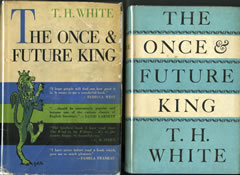The Once and Future King
You may click on the thumbnail images to view them full screen

White, T. H. The Once and Future King. London, Collins, 1958.
White, T. H. The Once and Future King. New York: Putnam's, 1958.
T. H. [Terence Hanbury] White (1906-1964) wrote a sequence of novels, the core of which is based on Malory's Morte. In fact, he even refers his readers to Malory if they want to hear episodes of the story that he is omitting. White adds to his source an enfance, the story of Arthur's youth, in The Sword in the Stone. Each of the first three parts was published separately, as The Sword in the Stone, The Witch in the Wood (a title later changed to The Queen of Air and Darkness), and The Ill-Made Knight. Though initially White thought in terms of a tetralogy, he developed a five-part structure and actually submitted to his publisher a book concluding with The Candle in the Wind and The Book of Merlyn, which remains important in understanding White's artistry in The Once and Future King, not so much because it is the most blatant exploration of the theme of war, which remains central to the book in its ultimate revision, but mainly because it is the key to the construction of the sequence. In the sequence of novels. It is perhaps not remarkable that Arthur and the other characters mature and age or that the author so clearly calls our attention to their aging. What is remarkable is that White reflects this aging in the macro-structure of his book. In a rather brilliant structural experiment, at the same time that the characters age in the sequence, the book itself, taken as a unified whole, is growing up with them. The Sword in the Stone is a children's book. Arthur's maturation makes The Queen of Air and Darkness a bildungsroman that bridges the gap between his childhood and his maturity. The Ill-Made Knight moves into the world of adult concerns and dangers. The characters and the sequence age again in its fourth part, The Candle in the Wind, which White first wrote as a tragedy. White intended to end his Arthuriad with The Book of Merlyn, which is a sort of philosophical dialogue on war and human nature. Thus, in the five parts of White's Arthuriad, the genres treated in the book "grow up" as the characters do.